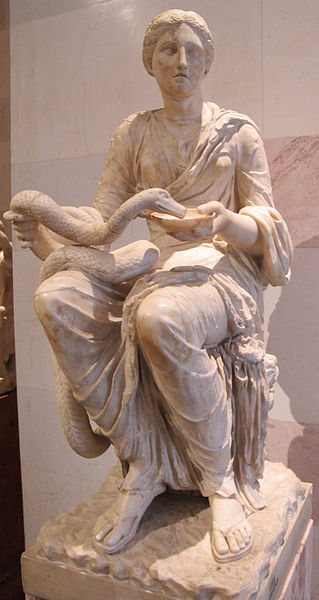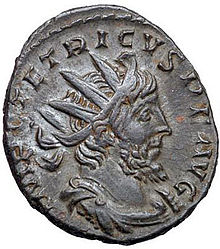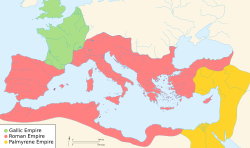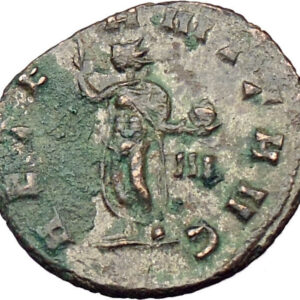|
Tetricus I
– Gallic
Roman Emperor
: 271-274 A.D. –
Bronze Antoninianus 20mm (2.98 grams) Struck 273 – 274 A.D.
Reference: RIC 127; Elmer 788; AGK (corr.) 11b; Cunetio hoard 2653; Sear 11247
var (obv legend).
IMP TETRICVS P F AVG, radiate and cuirassed bust right
SALVS AVGG, Salus standing left by altar, holding patera and rudder (or
anchor), feeding
serpent rising from altar.
You are bidding on the exact
item pictured, provided with a Certificate of Authenticity and Lifetime
Guarantee of Authenticity.
In
Greek
and
Roman mythology
, Hygieia (also Hygiea
or Hygeia, Greek Ὑγιεία or
Ὑγεία, Latin Hygēa or Hygīa),
was the daughter of the god of medicine,
Asclepius
, and
Epione
. She was the goddess/personification of
health, cleanliness and sanitation.

Hygieia
and her five sisters each performed a facet of
Apollo
‘s art: Hygieia (“Hygiene” the
goddess/personification of health, cleanliness, and sanitation),
Panacea
(the goddess of Universal remedy),
Iaso (the goddess of recuperation from illness),
Aceso
(the goddess of the healing process).
Hygieia also played an important part in her father’s
cult
. While her father was more directly
associated with healing, she was associated with the prevention of sickness and
the continuation of good health. Her name is the source of the word “hygiene“.
She was imported by the Romans as the Goddess Valetudo, the goddess of personal
health, but in time she started to be increasingly identified with the ancient
Italian goddess of social welfare,
Salus
.
History
At Athens, Hygieia was the subject of a local cult since at least the 7th
century BC. “Athena Hygieia” was one of the cult titles given to
Athena
, as Plutarch recounts of the building of
the Parthenon
(447-432 BC):
|
“ |
A strange accident happened in the course of building, which showed that
the goddess was not averse to the work, but was aiding and co-operating
to bring it to perfection. One of the artificers, the quickest and the
handiest workman among them all, with a slip of his foot fell down from
a great height, and lay in a miserable condition, the physicians having
no hope of his recovery. When Pericles was in distress about this, the
goddess [Athena] appeared to him at night in a dream, and ordered a
course of treatment, which he applied, and in a short time and with
great ease cured the man. And upon this occasion it was that he set up a
brass statue of Athena Hygieia, in the citadel near the altar, which
they say was there before. But it was
Phidias
who wrought the goddess’s image
in gold, and he has his name inscribed on the pedestal as the workman of
it. |
” |
However, the cult of Hygieia as an independent goddess did not begin to
spread out until the
Delphic oracle
recognized her, and after the
devastating
Plague of Athens
(430-427 BC) and in Rome in
293 BC.
In the 2nd century AD,
Pausanias
noted the statues both of Hygieia and
of Athena Hygieia near the entrance to the
Acropolis
of Athens.
Worship
Hygieia’s primary temples were in
Epidaurus
,
Corinth
,
Cos
and Pergamon
.
Pausanias
remarked that, at the Asclepieion
of Titane
in
Sicyon
(founded by
Alexanor
, Asclepius’ grandson), statues of
Hygieia were covered by women’s hair and pieces of
Babylonian
clothes. According to inscriptions,
the same sacrifices were offered at
Paros
.
Ariphron
, a Sicyonian artist from the 4th
century BC wrote a well-known
hymn celebrating her. Statues of Hygieia were created by
Scopas
,
Bryaxis
and
Timotheus
, among others, but there is no clear
description of what they looked like. She was often depicted as a young woman
feeding a large snake that was wrapped around her body or drinking from a jar
that she carried. These attributes were later adopted by the
Gallo-Roman
healing goddess,
Sirona
. Hygieia was accompanied by her brother,
Telesphorus
.
The
Pythagoreans
called the pentagram ὑγιεία Hugieia (“health”); also the Greek goddess of
health, Hygieia
and saw in the pentagram a mathematical perfection.
Caius Pius Esuvius Tetricus was Emperor of the
Gallic Empire
(Imperium Galliarum) from 270/271 to 273, following the
murder of Victorinus
. Tetricus, who ruled with his son, Tetricus II, was the last of
the Gallic emperors.
Tetricus was born to a noble family and held the administrative rank of
praeses provinciae
(provincial governor) of
Aquitania
at
the time of Victorinus
‘ death. Victorinus’ mother,
Victoria
, paid the army heavily to declare Tetricus emperor near Burdigalia
(Bordeaux,
France
), which
was approved in Gaul
and Britain
. Following his appointment, Tetricus repelled Germanic tribes that
took advantage of the confusion following the death of Victorinus to invade.
Tetricus installed his capital at Augusta Treverorum (present
Trier
,
Germany
, near
the vital Rhine border, hence later seat of a
Tetrarch
)
and appointed his son,
Tetricus
II
,
Caesar
(273). Tetricus made no attempts to expand the Gallic Empire,
other than southward, regaining
Aquitania
(which had rejoined the Roman empire during the reign of
Claudius
Gothicus
). In late 273 or early 274,
Faustinus
,
provincial governor of
Gallia Belgica
,
rebelled against him in
Augusta Treverorum
.
In 273, Emperor
Aurelian
set out to reconquer the western Roman empire, following his victories in the
east. Tetricus took his army southward from Trier to meet Aurelian, who was
advancing into northern Gaul. The
decisive battle
took place near
Châlons-sur-Marne
, where Tetricus and his son surrendered to Aurelian.
According to literary sources, after being displayed as trophies at
Aurelian’s
triumph
in Rome, the lives of Tetricus and his son were spared by Aurelian,
and Tetricus was even given the title of
corrector
Lucaniae et Bruttiorum, that is governor of a southern region of
Italia
. Tetricus died at an unknown date in Italy; he is listed as one of
Rome’s
Thirty Tyrants
in the
Historia Augusta
.
The Gallic Empire (Latin:
Imperium Galliarum) is the modern
name for a breakaway part of the
Roman Empire
that functioned de facto as
a separate state from 260 to 274.It originated during the
Crisis of the Third Century
.
The Gallic Empire under
Tetricus I
by 271 A.D. (in green)
It was established by
Postumus
in 260 in the wake of
barbarian
invasions and instability in
Rome, and at its height included the territories of
Germania
,
Gaul
,
Britannia
, and (for a time)
Hispania
. After Postumus’ assassination in 268
it lost much of its territory, but continued under a number of emperors and
usurpers. It was retaken by
Roman emperor
Aurelian
after the
Battle of Châlons
in 274.
History
Origins
The Roman
Crisis of the Third Century
continued as
Emperor
Valerian
was defeated and captured by the
Sassanid Empire
of
Persia
, leaving his son
Gallienus
in very shaky control. Shortly
thereafter, the
Palmyrene Empire
, which came to encompass
Egypt
,
Syria
,
Judea
, and
Arabia Petraea
also broke away.
The governors in
Pannonia
staged unsuccessful local revolts. The
Emperor left for the Danube to attend to their disruption. This left
Postumus
, who was governor of
Germania Superior
and
Inferior
, in charge at the Rhine border. An
exeptional administrator, Postumus had also protected the Germania Inferior
against an invasion led by the Franks in the summer of 260 very well. In fact,
Postumus defeated the Frankish forces at Empel so decisively, that there would
be no further Germanic raids for 10 years. This all would have combined to make
Postumus one of the most powerful men in the west of the Roman empire.
The imperial heir
Saloninus
and the praetorian prefect Silvanus
remained at Colonia Agrippina (Cologne),
to keep the young heir out of danger and perhaps also as a check on Postumus’
ambitions. Before long, however, Postumus besieged Colonia Agrippina and put the
young heir and his guardian to death, making his revolt official. Postumus is
thought to have established his capital at Cologne or Trier,[2]
with Lugdunum also becoming an important city in the empire.
The Gallic Empire had its own praetorian guard, two annually elected consuls
(not all of whose names have survived) and probably its own senate. According to
the numismatic evidence, Postumus himself held the office of consul five times.

Coin of
Tetricus
, last emperor (271–274) of
the Gallic Empire
Postumus successfully fended off a military incursion by Gallienus in 263,
and was never challenged by him again. However, in early 268 he was challenged
by Laelianus
, probably one of his commanders, who
was declared emperor at Mogontiacum (Mainz)
by his
Legio XXII Primigenia
. Postumus quickly retook
Mogontiacum and Laelianus was killed. Postumus himself, however, was overthrown
and killed by his own troops, reportedly because he did not allow them to sack
the city.[3][4]
After Postumus
After the death of Postumus, the Gallic Empire began to decline. Roman
Emperor
Claudius Gothicus
re-established Roman
authority in
Gallia Narbonensis
and parts of
Gallia Aquitania
, and there is some evidence
that the provinces of Hispania, which did not recognize the subsequent Gallic
Emperors, may have re-aligned with Rome then.[5][6]
Marius
was instated as Emperor upon Postumus’
death, but died very shortly after; ancient sources writing much later state
that he reigned only two days, though it is more likely, as displayed through
the numismatic record, that he reigned for a few months.[7]
Subsequently
Victorinus
came to power, being recognized as
Emperor in northern Gaul and Britannia, but not in Hispania.[5]
Victorinus spent most of his reign dealing with insurgencies and attempting to
recover the Gaulish territories taken by Claudius Gothicus. He was assassinated
in 271, but his mother
Victoria
took control of his troops and used
her power to influence the selection of his successor.[5]
With Victoria’s support,
Tetricus
was made Emperor, and was recognized
in Britannia and the parts of Gaul still controlled by the Empire.[8]
Tetricus fought off Germanic barbarians who had begun ravaging Gaul after the
death of Victorinus, and was able to re-take Gallia Aquitania and western Gallia
Narbonensis while Roman Emperor
Aurelian
was engaging Queen
Zenobia
‘s
Palmyrene Empire
in the east. He established
the imperial court at Trier
, and in 273 he elevated his son,
also named Tetricus
, to the rank of
Caesar
. The following year the younger Tetricus
was made co-consul, but the Empire grew weak from internal strife, including a
mutiny led by the usurper
Faustinus
.[8]
By that time Aurelian had defeated the Palmyrene Empire and had made plans to
re-conquer the west. He moved into Gaul and defeated Tetricus at the
Battle of Châlons
in 274; according to some
sources, Tetricus offered to surrender in exchange for clemency for him and his
son before the battle.[8]
This detail may be later propaganda, but either way, Aurelian was victorious,
and the Gallic Empire was effectively dismantled.[8]
Causes
The Gallic Empire was symptomatic of the fragmentation of power during the
third-century crisis. It has also been taken to represent autonomous trends in
the western provinces, including proto-feudalistic tendencies among the Gaulish
land-owning class whose support has sometimes been thought to have underpinned
the strength of the Gallic Empire, and an interplay between the strength of
Roman institutions and the growing salience of provincial concerns.[10]
One of Postumus’ primary objectives as emperor was evidently the defence of the
Germanic frontier; in 261 he repelled mixed groups of
Franks
and
Alamanni
to hold the Rhine
limes
secure (though lands beyond the upper
Rhine and Danube had to be abandoned to the barbarians within a couple of
years). In so doing, Postumus positioned himself avowedly as not only the
defender and restorer of Gaul, but also as the upholder of the Roman name.
The usurpation of power over Britain and northern Gaul by
Carausius
just twenty years later reflects a
continuing trend by which local loyalties from the landed aristocracy and
deteriorating morale in the legions enabled Carausius to seize power in Britain.[citation
needed] Similarly with the withdrawal of legions
after 408, many Britons desired a localized Roman authority rather than
nationalist revolt. The desire for Roman order and institutions was entirely
compatible with a degree of national or regional separatism.
Gallic Emperors
The Gallic Emperors are known primarily from the
coins they minted. The political and military history of the Gallic
Empire can be sketched through the careers of these emperors. Their names are as
follows:
- Postumus
260–268
-
Marius
268
- Victorinus
268–270
- (Domitianus
271? usurper)
- Tetricus the elder
[14]
270–274
-
Tetricus the younger
270–274 (son of
Tetricus;
caesar
)
Consuls of the
Gallic Empire
| Year |
Consul |
Consul |
| 260 |
Postumus
(second time) |
unknown |
| 261 |
Postumus (third time) |
| 262 |
unknown |
| 263 |
| 264 |
| 265 |
Postumus (fourth time) |
| 266 |
| 267 |
unknown |
| 268 |
Postumus (fifth time) |
Victorinus
(first time) |
| 269 |
unknown |
unknown |
| 270 |
Victorinus (second time) |
Sanctus |
| 271 |
Tetricus
(first time) |
unknown |
| 272 |
Tetricus (second time) |
| 273 |
Tetricus (third time) |
| Year and sequence unknown: |
| ? |
Censor (twice) |
Lepidus (twice) |
| ? |
Dialis |
Bassus |
| ? |
“Apr.” |
“Ruf.” |
|











